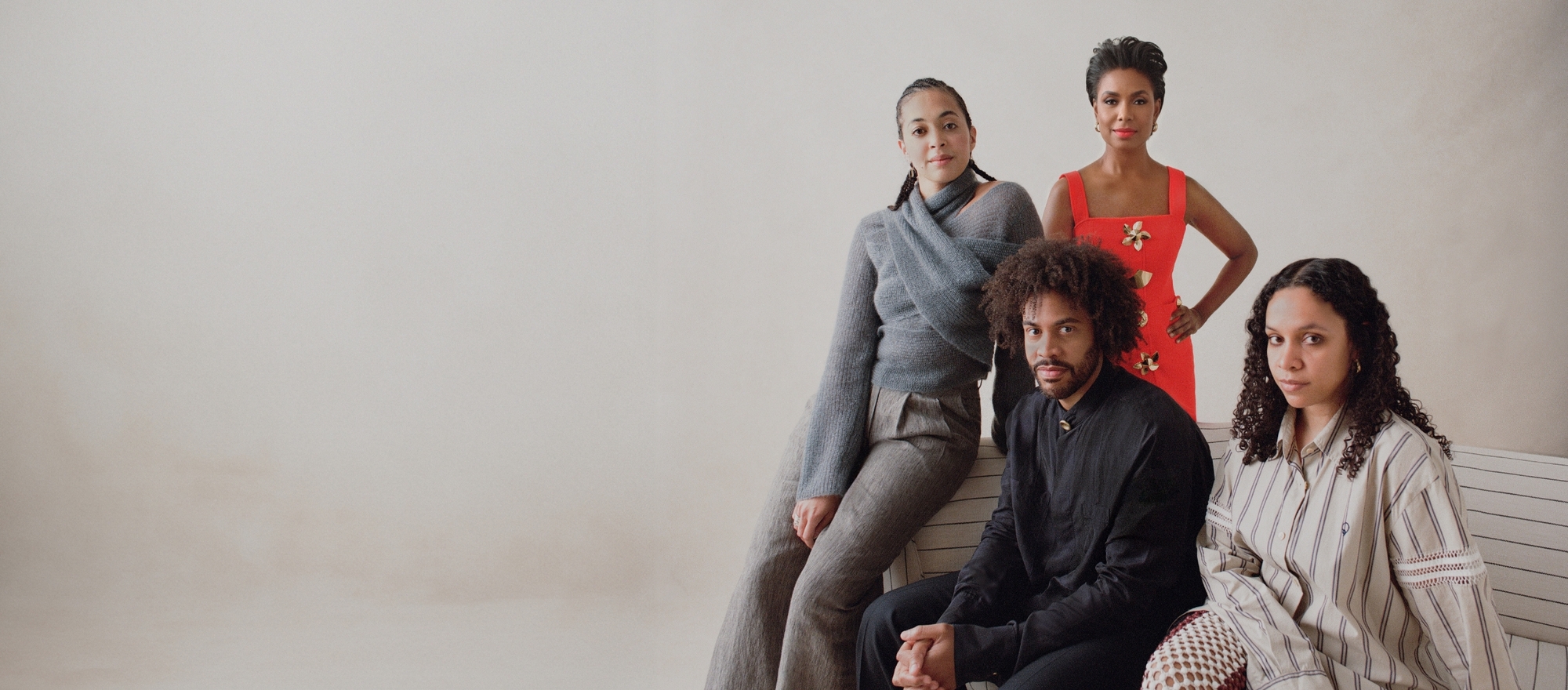

Felita: Take me back to the beginning. What started the interests for all of you in pursuing a career in the fashion industry?
Aisling: “Style with Elsa Klensch”—my mother would always watch it while I was growing up in Trinidad. When that came on, everyone had to get out of the living room because it was time to watch fashion.
Charles: It started with watching the process of my mom getting dressed. Particularly being a little queer boy loving pretty things. I thought I’d be an architect, but I had some sketches that a school counselor saw and said, “Actually Charles, I think you should consider fashion.” This was back in North Carolina.
Rachel: It also starts with my mother, but with her clothes. This is Jamaica in the ‘80s, so there was lamé and sequins and Lurex. I’d play in her closet all the time. I wanted to be an interior designer and had summer internships, but I was going to parties all the time so I needed looks for those parties and that’s when I started making clothes.
Felita: Charles, you have a story of trial and triumph. You have fought, traveled, and overcome a lot of obstacles. Would you be comfortable being transparent in that?
Charles: Yeah… I’m fresh off a red-eye. [laughs]
Felita: I think it’s important to share…
Charles: It’s interesting, when you love something almost more than yourself, you can lose yourself. At some point, I lost myself in design. I realized I am the source of these things—these ideas. Albeit, I don t think they are mine. They come from inspiration around the world and spiritual inspiration. Even being a conduit, I have to protect and fortify myself. It was a really hard decision to place the brand on hiatus [in 2016], to close everything, disappear, and figure out how to center myself, but I’m so glad I did. I think it’s important for all creatives, specifically designers and those who are at the center of these brands, to understand that not only do our stories matter, not only do our ideas and inspirations matter, but also that we matter.
Felita: …And also, the family around you and other designers that support those journeys.
Charles: We are tribes. And particularly as Black people, as African heritage people, it’s central to us culturally to be a collective. That’s the beautiful thing about fashion as well—you can establish communities amongst yourselves in a really beautiful way.
Felita: You’ve all achieved great accomplishments this year. Rachel, winning the CFDA Emerging Designer of the Year award. Aisling, winning the Fashion Trust Ready-To-Wear Designer Of The Year Award, and Charles, relaunching your Harbison Studio collection as well as collaborations that sold out across North America. What do these accolades mean after so much sacrifice?
Aisling: Having come from a mechanical engineering background, I’ve always felt like an outsider looking in. So, I never really focused on getting the approval. I just put my head down and worked. It’s a bonus that people are appreciating and giving me the love for it.
Rachel: It feels great to be seen. Winning the Emerging Designer of The Year was a complete shock. You’re nominated by people who are members of the CFDA, and then the people who are nominated are again voted on by the people in the CFDA. So you are being recognized by your peers. I was so honored. I will add, with the LVMH prize and the CFDA Vogue Fashion Fund, those are competitions with [positive] financial repercussions…
Aisling: The cash flow I think is the trickiest part of keeping things moving. You’re building something for six to nine months, you’re footing the bill for that entire process. You’re sourcing, developing, sampling. You’re paying for models. For me, actually, that financial support was the most helpful thing. I didn’t want to say money [laughs] but you re absolutely right!
Rachel: Let’s be honest!
Aisling: “Style with Elsa Klensch”—my mother would always watch it while I was growing up in Trinidad. When that came on, everyone had to get out of the living room because it was time to watch fashion.
Charles: It started with watching the process of my mom getting dressed. Particularly being a little queer boy loving pretty things. I thought I’d be an architect, but I had some sketches that a school counselor saw and said, “Actually Charles, I think you should consider fashion.” This was back in North Carolina.
Rachel: It also starts with my mother, but with her clothes. This is Jamaica in the ‘80s, so there was lamé and sequins and Lurex. I’d play in her closet all the time. I wanted to be an interior designer and had summer internships, but I was going to parties all the time so I needed looks for those parties and that’s when I started making clothes.
Felita: Charles, you have a story of trial and triumph. You have fought, traveled, and overcome a lot of obstacles. Would you be comfortable being transparent in that?
Charles: Yeah… I’m fresh off a red-eye. [laughs]
Felita: I think it’s important to share…
Charles: It’s interesting, when you love something almost more than yourself, you can lose yourself. At some point, I lost myself in design. I realized I am the source of these things—these ideas. Albeit, I don t think they are mine. They come from inspiration around the world and spiritual inspiration. Even being a conduit, I have to protect and fortify myself. It was a really hard decision to place the brand on hiatus [in 2016], to close everything, disappear, and figure out how to center myself, but I’m so glad I did. I think it’s important for all creatives, specifically designers and those who are at the center of these brands, to understand that not only do our stories matter, not only do our ideas and inspirations matter, but also that we matter.
Felita: …And also, the family around you and other designers that support those journeys.
Charles: We are tribes. And particularly as Black people, as African heritage people, it’s central to us culturally to be a collective. That’s the beautiful thing about fashion as well—you can establish communities amongst yourselves in a really beautiful way.
Felita: You’ve all achieved great accomplishments this year. Rachel, winning the CFDA Emerging Designer of the Year award. Aisling, winning the Fashion Trust Ready-To-Wear Designer Of The Year Award, and Charles, relaunching your Harbison Studio collection as well as collaborations that sold out across North America. What do these accolades mean after so much sacrifice?
Aisling: Having come from a mechanical engineering background, I’ve always felt like an outsider looking in. So, I never really focused on getting the approval. I just put my head down and worked. It’s a bonus that people are appreciating and giving me the love for it.
Rachel: It feels great to be seen. Winning the Emerging Designer of The Year was a complete shock. You’re nominated by people who are members of the CFDA, and then the people who are nominated are again voted on by the people in the CFDA. So you are being recognized by your peers. I was so honored. I will add, with the LVMH prize and the CFDA Vogue Fashion Fund, those are competitions with [positive] financial repercussions…
Aisling: The cash flow I think is the trickiest part of keeping things moving. You’re building something for six to nine months, you’re footing the bill for that entire process. You’re sourcing, developing, sampling. You’re paying for models. For me, actually, that financial support was the most helpful thing. I didn’t want to say money [laughs] but you re absolutely right!
Rachel: Let’s be honest!